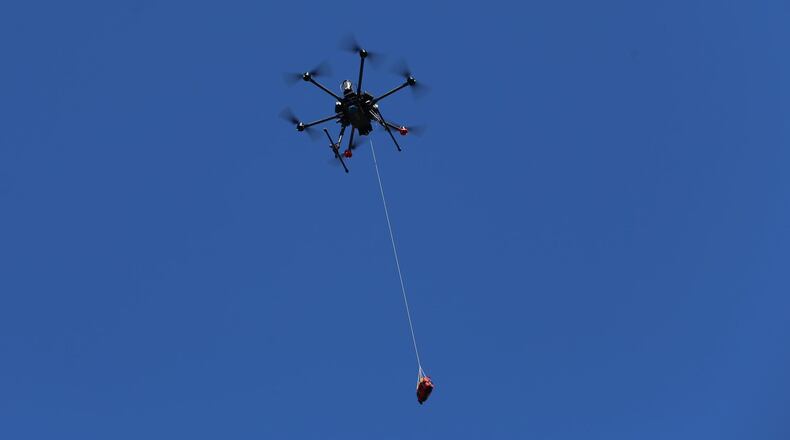Last December, a 71-year-old man in Sweden received an early Christmas present: a new chance at life, delivered via drone.
While shoveling snow in front of his home, he suffered a cardiac arrest. A passerby, Mustafa Ali, saw the man collapse and called emergency response.
After three minutes, before the first responders even arrived on the scene, a drone hovered over the driveway.
“First, I thought, there’s somebody filming here,” Ali told Euronews, a television news network, “but someone from the alarm center said, ‘Here is your defibrillator, so just pick it up.’ Okay!”
The drone winched down an automated external defibrillator (AED), with clear instructions on where to attach its yellow pads to the patient’s body. The quick rescue saved the patient’s life.
Credit: contributed
Credit: contributed
Sweden is the first country in the world that began to equip drones with AEDs. In the December emergency, the first responders were there within five minutes, but the drone was there in three.
While that may sound like only a slight difference, it can mark the frontier between life and death.
Too often, said Magnus Hallberg, a developer at the drone company Everdrone, bystanders don’t know how to perform first aid and defibrillators are rarely at hand.
In the two years since the pilot project began in Sweden, a study found that 95 percent of the drones arrived safely and quickly. Ambulances can get stuck in traffic jams that drones simply traverse as the crow flies.
In this particular case, it helped that Ali is a medical doctor who was on his way to the hospital and did not hesitate to immediately render first aid. But even people with no medical background can help save a life.
Once the AED is attached to the patient, it automatically detects the patient’s heart rhythm and will only deliver shocks when it ascertains a cardiac arrest. “You don’t have to do anything as a bystander other than attach the AED,” Hallberg explained.
What makes the Swedish example noteworthy is that the drones get sent on their way immediately, as soon as an emergency is classified as a cardiac arrest.
“The drone is airborne within 60 seconds,” Hallberg said. “On average, it takes 10 to 11 minutes until the ambulance arrives.” Everdrone coordinates the project with Sweden’s largest medical university and the national Swedish emergency center, SOS Alarm.
When the center receives a call that fits the criteria for a cardiac arrest, the operator will instruct the caller on rendering first aid, while simultaneously sending an ambulance and a drone on their ways.
While the scope of the pilot project was limited, Everdrone is about to expand to more regions and other countries.
When speed is of the essence, such as after a cardiac arrest or a snake bite, or in remote and medically underserved communities where patients face long transports to clinics and pharmacies, the drones are hard to beat.
The movement is growing around the globe
Google has patented a drone system for medical deliveries that includes AEDs. Backed by Google Ventures and Microsoft co-founder Paul Allen, the US company Zipline has tried out its medical deliveries on other continents, in Ghana and Rwanda for example, and is planning to extend to transport blood, antibiotics, prescription medication and vaccines in rural areas in Maryland, Nevada, North Carolina, Utah and Washington State.
The Navajo Nation in Arizona just received its first medical delivery from a different drone developer, ZappCare, to secure medication delivery in hard-to-reach areas.
And a German company, Wingcopter, has used its drones to deliver coronavirus vaccines and masks for COVID-19 prevention in far-flung areas, including a UNICEF initiative on the island state Vanuatu in the South Pacific.
Drones are not new technology in public safety.
Fire departments, police stations and companies routinely use drones, for example to monitor at-risk areas in search-and-rescue or to check power lines.
Even with the advantages of speed and decreased emissions, there are some substantial disadvantages.
Some areas are not suitable for drones. For example, narrow alleys, crowds or power lines can prohibit landings. Expensive medication or devices could get lost despite the GPS. And many drones can’t fly in strong wind or rain, though their design continues to improve.
“Speed is everything,” Timothy Amukele, a pathologist at Johns Hopkins Hospital in Baltimore, is quoted on the website, Drones in Healthcare, after finishing a proof-of-concept study to deliver blood samples via drone.
If you’re wondering, there is a reason many drone companies have been active outside the United States first: While the United States has eased some regulations, bureaucratic hurdles remain.
Yet, most experts believe it is only a matter of time until drones will become standard in medical care.
“People are starting to realize that drones can be used for good,” Amukele said. “Already, in the United States, they are being used for agriculture and film-making, but what they haven’t been used for is healthcare. Healthcare is the industry where we need this capacity.”
By Michaela Haas writes for Reasons to Be Cheerful, a nonprofit editorial project that strives to serve as a tonic for tumultuous times.
About the Solutions Journalism Network
This story comes from our partners at the Solutions Journalism Network, a nonprofit organization dedicated to rigorous reporting about social issues.
About the Author
Keep Reading
The Latest
Featured



